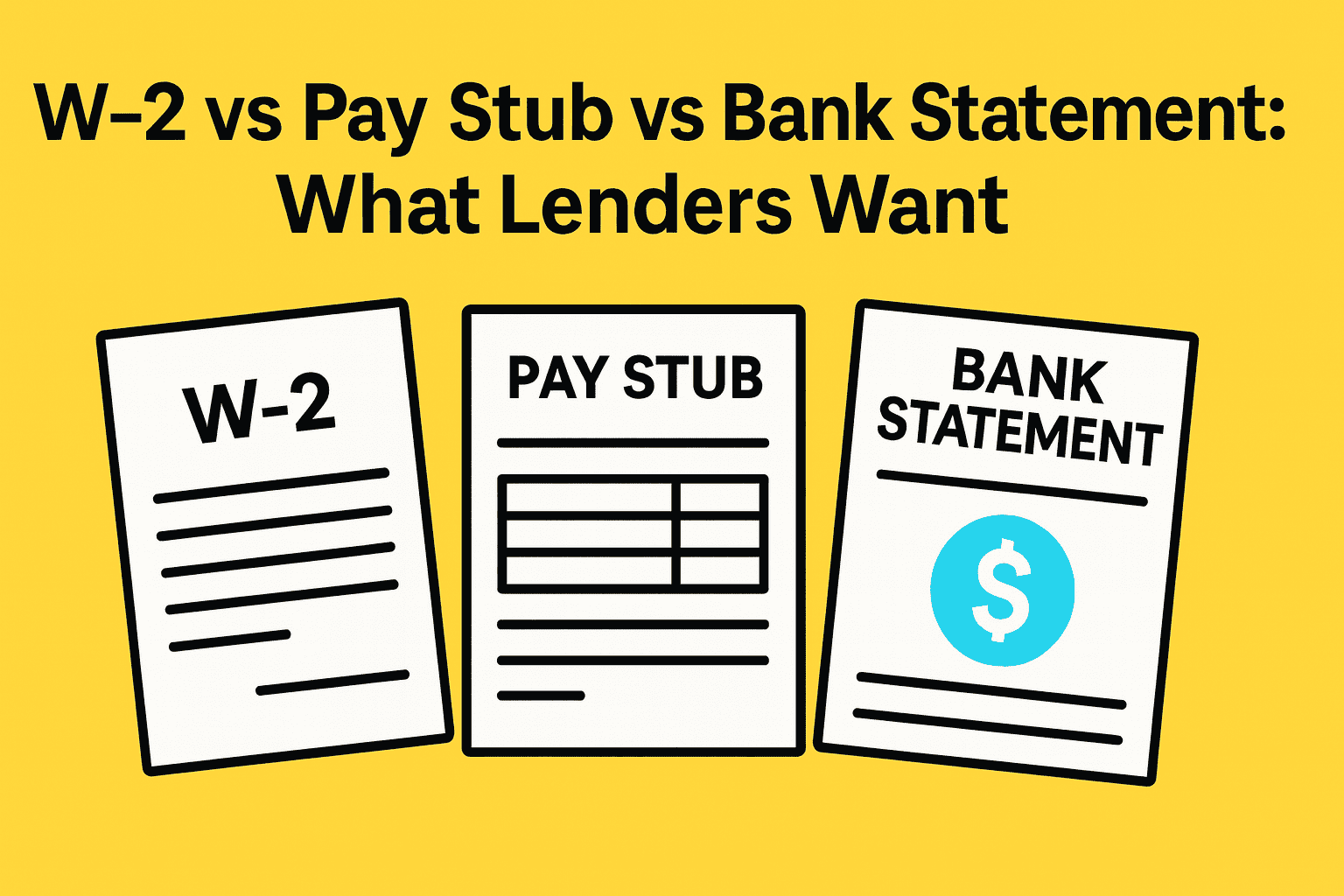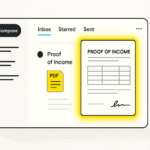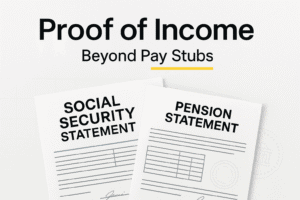Introduction
Last updated: April 2024
When applying for a loan—whether it’s a mortgage, personal loan, or business financing—lenders will ask for key documents. The three most important are W-2s, Pay Stubs, and Bank Statements. But when does each one matter most?
This guide breaks down W-2 vs Pay Stub vs Bank Statement, what lenders expect from each, and how to make sure your documents are clear, compliant, and ready for review in the U.S., U.K., or Canada.
Related Entities & Terms
- IRS Form W-2 (U.S.)
- P60 (U.K. equivalent to W-2)
- T4 Slip (Canada equivalent)
- Pay Slip / Payslip
- Bank Statement (monthly financial history)
- Proof of Income
- Direct Deposit Record
- Financial Authorization Letter
- Employment Verification
- Loan Pre-Approval
- AML & KYC Compliance
Note: You may improve formatting or legibility for lawful reasons. But changing numbers, dates, or payee names is illegal and may be considered fraud.

W-2s: What They Tell Lenders

In the U.S., W-2 forms report annual earnings, withheld taxes, and benefits. Employers issue them at year-end. They’re a trusted way for lenders to verify your yearly income.
What’s in a W-2?
- Total gross pay
- Taxes withheld (federal, state, local)
- Social Security/Medicare contributions
- Employer and employee info, EIN
U.K. Equivalent: P60 and P45 forms show yearly earnings.
Canada Equivalent: T4 slips issued by employers annually.
Why Lenders Trust W-2s
- Filed with the government
- Hard to fake and easy to verify
- Shows full-year income history
Pay Stubs: Short-Term Proof of Earnings
Pay stubs, or payslips, show your income for each pay period. They help prove recent earnings and employment status.
What They Show
- Gross and net income (current and year-to-date)
- Taxes and benefit deductions
- Pay period dates and employer info
Why Lenders Like Pay Stubs
- Shows you’re actively employed
- Useful for new hires or gig workers
- Easy to download or print from payroll systems
It’s usually fine to cover personal benefit details for privacy. Proof of income formatting must still be accurate and legal.
Bank Statements: Showing Real Cash Flow
Bank statements track your real money activity—deposits, bills, and balances. Lenders use them to confirm income and spot risk signs.
What Statements Contain
- Deposit history (from jobs or freelance)
- Outgoing payments and bills
- Account balances and overdrafts
How Lenders Use Them
- Check if income arrives as stated
- Spot red flags like overdrafts or debt
- Double-check other docs
Bad formatting can delay your loan. Learn more about clean formats for bank statements.
W-2 vs Pay Stub vs Bank Statement: When Each Is Used
U.S. Lenders
- W-2: Trusted for salary proof
- Pay Stub: Verifies recent work
- Bank Statements: Show real deposits
U.K. Lenders
- P60: Annual income proof
- Payslips (3–6 months): Confirm regular earnings
- Bank Statements (3–6 months): Spot risks or debt
Canadian Lenders
- T4 Slip: Yearly salary verification
- Recent Pay Slips (2–3): Active employment check
- Bank Statements: Review money flow and behavior
Loan Document Requirements by Loan Type
Mortgages
- Two years of W-2s or local equivalent
- Two to three months of bank statements
- Last 30–60 days of pay stubs
Auto Loans
- One to two recent pay stubs
- Recent bank statements
Personal Loans
- Proof of current job (pay stubs)
- Two to three months of bank records
Business Loans
- Business banking records
- Owner’s personal income docs (W-2, T4, etc.)
- Profit and Loss reports
Visit consumerfinance.gov for official loan document lists.
What Lenders Look For in Your Financials
Lenders watch for key traits in your documents:
- Income across forms matches
- No suspicious activity (like big cash deposits)
- Your job info is real and current
- No signs of forgery or edits
Formatting Considerations & Compliance
Lenders often reject files for being hard to read or poorly scanned. In the U.S., falsifying documents is a federal crime. In Canada or the U.K., it breaks anti-money laundering laws.
Never change: pay amounts, dates, employer names, or deposit amounts.
Get help with document formatting to avoid these issues.
Common Mistakes to Avoid
- Using old documents (over 90 days)
- Mixing unrelated income types
- Uploading poor scans or crops
- Redacting key data lenders need
Mini Scenarios: What Could Go Wrong
- Scenario 1: Someone submits fake pay stubs. The lender checks the employer and denies the loan—fraud charges follow.
- Scenario 2: A bank statement shows two bounced rent payments. The lender lowers the approved loan because of the risk.
- Scenario 3: A U.K. borrower sends just 2 months of payslips when 6 were required—approval delayed, and a property is lost.
Compliance Snapshot
| Document | Time Range | Key Use | Accepted Format |
|---|---|---|---|
| W-2 / P60 / T4 | 1–2 Years | Long-term income | PDF or original copy |
| Pay Stubs / Payslips | 30–90 Days | Employment status | PDF or employer printout |
| Bank Statements | 2–6 Months | Cash flow validation | PDF or official extract |
Related Services and Reliable Help
Need help reviewing, organizing, or formatting your financial docs? Our team can support income documentation and bank formatting. See services and pricing or contact us now.
Want to explore our approach first? Read how we work.
Final Thoughts: Documentation Done Right
Each lender and loan type has different rules. But whether you’re using a W-2, Pay Stub, or Bank Statement, your goal stays the same: prove your income is steady and clear.
Send in documents that are legal, clean, and up-to-date—and you’ll boost your approval chances.
Call to Action
Need accurate, reliable financial documents fast? Contact FinancialDocsProvider.com now.
FAQ Section
What’s the difference between a W-2 and a pay stub?
A W-2 shows income and tax info for an entire year. A pay stub shows one pay period’s earnings.
Do lenders accept online bank statements?
Yes, if they come from your bank’s portal and show full, unchanged info.
How many months of documents do I need?
Usually 2–6 months of bank statements and 1–3 months of pay stubs. W-2s cover 1–2 past years.
Can I redact sensitive data from my documents?
You can remove non-required items like insurance info. Don’t remove income, dates, or key details.
Is it legal to format documents for clarity?
Yes. Formatting is allowed as long as nothing is changed or misrepresented.
Frequently Asked Questions
Q: What’s the difference between a W-2 and a pay stub?
A: A W-2 shows income and tax info for an entire year. A pay stub shows one pay period’s earnings.
Q: Do lenders accept online bank statements?
A: Yes, if they come from your bank’s portal and show full, unchanged info.
Q: How many months of documents do I need?
A: Usually 2–6 months of bank statements and 1–3 months of pay stubs. W-2s cover 1–2 past years.
Q: Can I redact sensitive data from my documents?
A: You can remove non-required items like insurance info. Don’t remove income, dates, or key details.
Q: Is it legal to format documents for clarity?
A: Yes. Formatting is allowed as long as nothing is changed or misrepresented.








Add comment